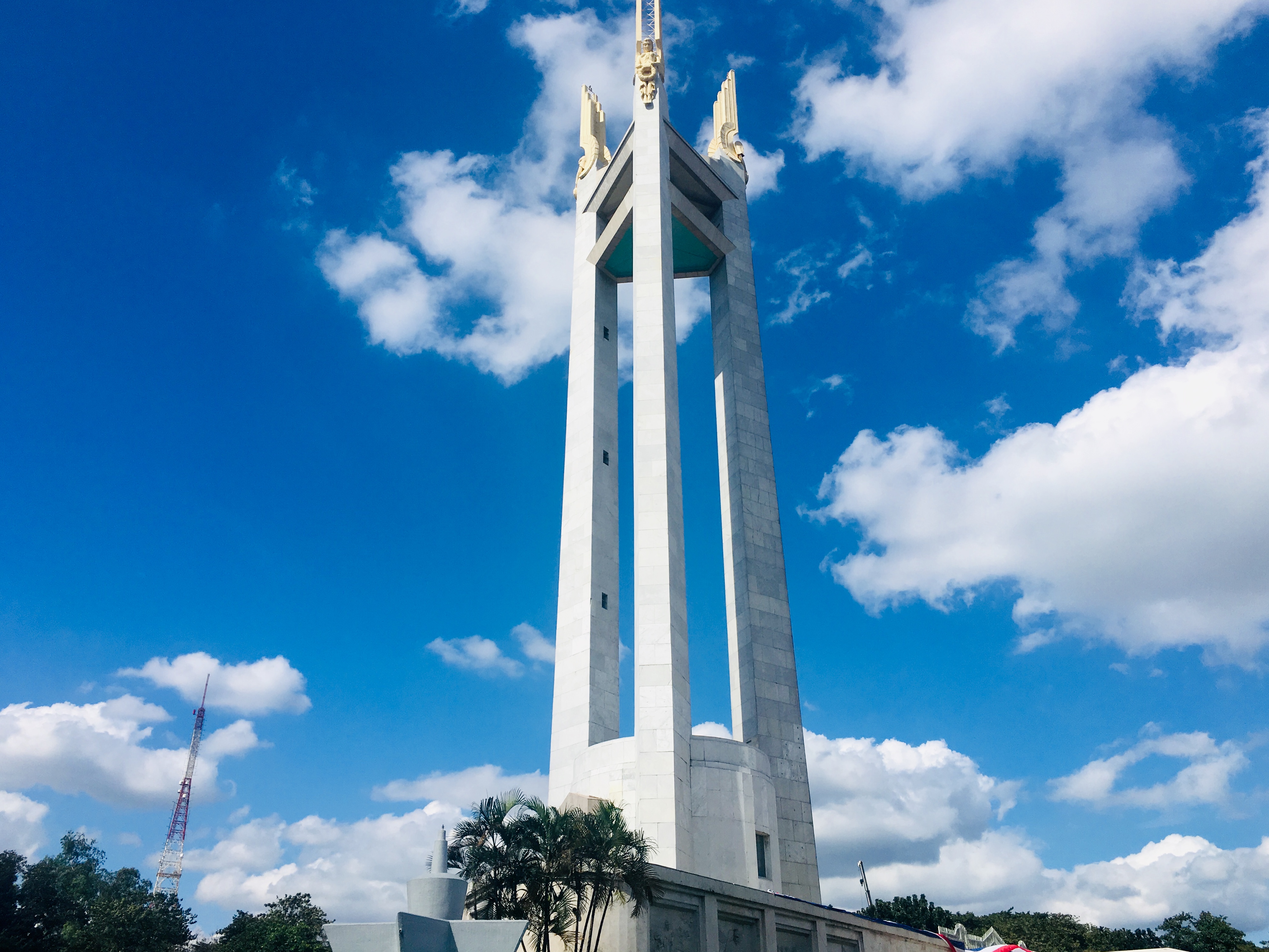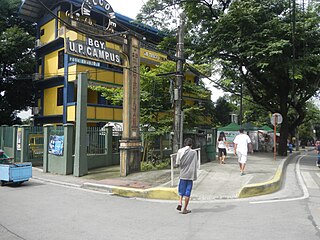
The University of the Philippines Diliman, also referred to as UPD, UP Diliman, or simply University of the Philippines or UP, is a public, coeducational, research basic and higher education institution located in Diliman, Quezon City, Philippines. It was established on February 12, 1949, as the flagship campus and seat of administration of the University of the Philippines System, the national university of the Philippines.

Quezon City, also known as the City of Quezon and Q.C., is the most populous city in the Philippines. According to the 2020 census, it has a population of 2,960,048 people. It was founded on October 12, 1939, and was named after Manuel L. Quezon, the second president of the Philippines.

The Oblation is a concrete statue by Philippine National Artist artist Guillermo Tolentino which serves as the iconic symbol of the University of the Philippines. It depicts a man facing upward with arms outstretched, symbolizing selfless offering of oneself to his union.

Leandro V. Locsin was a Filipino architect, artist, and interior designer known for his use of concrete, floating volume and simplistic design in his various projects. An avid collector, he was fond of modern painting and Chinese ceramics. He was proclaimed a National Artist of the Philippines for Architecture in 1990 by the late President Corazon C. Aquino.

Francisco "Bobby" Tronqued Mañosa was a Filipino architect considered one of the most influential Filipino architects of the 20th century for having pioneered the art of Philippine neovernacular architecture. His contributions to the development of Philippine architecture led to his recognition as a National Artist of the Philippines for Architecture in 2018.
This is a list of current and former national capital cities in the Philippines, which includes during the time of the Spanish colonization, the First Philippine Republic, the Commonwealth of the Philippines, the Second Republic of the Philippines, the Third Republic of the Philippines, the Fourth Republic of the Philippines and the current Fifth Republic of the Philippines.

The Parish of the Holy Sacrifice, also known as the Church of the Holy Sacrifice, is a landmark Catholic chapel on the University of the Philippines Diliman campus. It belongs to the Roman Catholic Diocese of Cubao and its present parish priest is Rev. Fr. Jose S. Tupino III. More popularly known as the UP Chapel, the church was constructed under the supervision of Fr. John P. Delaney, who began ministering to the spiritual needs of the campus in 1947.

The architecture of the Philippines reflects the historical and cultural traditions in the country. Most prominent historic structures in the archipelago are influenced by Austronesian, Chinese, Spanish, and American architectures.

David Sobrepeña is president of the Union College of Laguna. He was born to Bishop Enrique Sobrepeña and Petra Sobrepeña. He is a native of La Union, a northern province in the Philippines. He succeeded his mother as president of the Union College; she occupied the position upon the demise of his father, the College founder.

The Manila Central Post Office, often called the Post Office Building, is the main postal office of Manila, which also serves as the home of the Philippine Postal Corporation. It also houses the main mail sorting-distribution operations of the Philippines.
The Insular Life Assurance Company, Ltd. is a mutual life insurance company in the Philippines. Established on November 25, 1910 in Manila, it is the first Filipino life insurance company. The company offers individual and group life, health, education and retirement insurance plans. It provides allied financial services such as general insurance, banking, healthcare, lending and investment through subsidiaries and affiliate companies in its eponymous corporate group. Insular Life was once a member of the Ayala Corporation until 1987, when it became a mutual company owned by its policyholders. Its Executive Chairman of the Board is Nina D. Aguas and its Chief Executive Officer is Raoul Antonio E. Littaua. As of 2020, it is the tenth largest life insurer in the Philippines in terms of premium income, and fourth in terms of net worth.

The University of Santo Tomas Central Seminary Building currently houses the Santísimo Rosario Parish, the Central Seminary, and the Faculties of Ecclesiastical Studies of the Pontifical and Royal University of Santo Tomas in Manila. The Parish was canonically inaugurated on April 26, 1942 by Michael J. O'Doherty, the Archbishop of Manila. On January 25, 2010, the National Museum of the Philippines formally declared the Central Seminary Building as a National Cultural Treasure.
Carlos D. Arguelles was a Filipino architect who was known for being a leading proponent of the International Style of architecture in the Philippines in the 1960s. He was an Eagle Scout and a Distinguished Eagle Scout Awardee of the Boy Scouts of America.

The Legarda Elementary School is a public elementary school located in Sampaloc in the City of Manila. Built in 1922, the school is notable for its main school building that has managed to retain its pre-war architecture, making its building the oldest surviving campus in Manila.
The Iglesia Ni Cristo Locale of F. Manalo-San Juan, formerly Locale of Riverside is a chapel and former central office complex of the Philippine-based Christian sect, Iglesia ni Cristo. Located in Barangay Santa Lucia, San Juan, it was completed in 1952, and it is the former central office complex and main house of worship of the church. The art-deco ensembles were designed by the national artist of architecture Juan Nakpil, who also built some of the standalone theaters in Rizal Avenue, UP Diliman Campus buildings and Quiapo Church.

The Quezon Memorial Shrine is a monument and national shrine dedicated to former Philippine President Manuel Quezon located within the grounds of Quezon Memorial Circle in Quezon City, Metro Manila. It also houses a museum at its base.

Krus na Ligas is a barangay in Diliman, Quezon City in the Philippines. It is located within the premises of the University of the Philippines Diliman. It has a population of 21,513 based on the census conducted in 2015.

U.P. Campus is a barangay in Quezon City, Metro Manila. As its name suggests, a large part of the barangay is occupied by the main Diliman campus of the University of the Philippines (UP). UP Diliman, the university campus itself, covers seven other barangays in Quezon City, namely Krus na Ligas, San Vicente, Botocan, Culiat, Old Capitol Site, Pansol and Vasra.
The Freedom Memorial Museum is an under-construction museum to be built inside the University of the Philippines Diliman campus in Quezon City, Metro Manila, Philippines. It will feature exhibits related to the Martial Law era under former President Ferdinand Marcos.
Cesar Homero Rosales Concio Sr. was an architect who as the first University Architect of the University of the Philippines designed many buildings in the University of the Philippines Diliman campus. He was also one of the architects who created the Makati Central Business District. Concio's architecture has been described in the Encyclopedia of Art as “a rational approach to design, resulting in logically arranged spaces, neatness of form, and a successful adaptation to climate".














